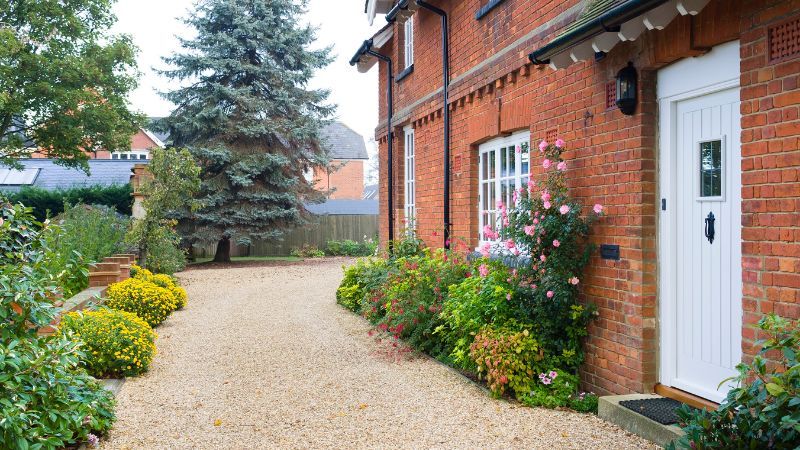Categories
What is a Bridging Mortgage?

A bridging mortgage, usually referred to as a bridging loan, can help you act like a cash buyer when purchasing property.
Written by: Sam Hodgson
Bridging mortgages, or bridging loans, are short-term property financing solutions designed to help borrowers quickly secure funds, often within 12 months.
These loans are commonly used to fund a gap in finance between purchasing a new property and selling an existing one, offering flexibility not typically available with standard mortgages.
Key takeaways:
- A bridging mortgage is another word for a bridging loan, a form of short term finance.
- They are more flexible and can typically be accessed more quickly than a mortgage, making them popular for time-sensitive purchases or when breaking a mortgage chain.
- Bridging mortgages typically last for around 12 months and requires a solid exit strategy, such as proceeds from a property sale.
- The application process usually considers the equity in your current property, valuations, and overall financial circumstances.
- How much a bridging mortgage costs will depend on your loan-to-value (LTV), term length, and any lender-specific fees.
Skip to:
How Does a Bridging Mortgage Work?
What Are Bridging Mortgages Used For?
What Do Bridging Mortgages Cost?
How To Get a Bridging Mortgage?
How Does a Bridging Mortgage Work?
A bridging mortgage is often used to "bridge" the gap between purchasing a new property and selling an existing property.
To explain, it provides a temporary source of funding to help homeowners complete a purchase of a home they may have their eye on or a property in which they’d have to move fast to secure.
With a bridging mortgage, you don’t have to worry about selling your existing property initially or being stuck in between without the necessary funds to hand.
In this post, we’ll guide you through the ins and outs of bridging mortgages and include some examples of just how versatile they can be – we’ll show you:
- How they work
- What they can be used for
- How much they cost
- How much you can borrow
- Eligibility criteria and how to apply

Assessment
When a homeowner applies for a loan, the lender will assess their financial situation, including the equity in their existing property and the expected sale proceeds.

Approval
If the lender approves the loan, the homeowner can proceed with the purchase of the new property - the loan is then secured against the borrower's existing property.

Repayment/exit strategy
The borrower will need a solid exit strategy in place, which is typically the proceeds from a property sold (which would be the property the loan is secured against). The repayment will differ for each borrower, depending on the terms and criteria of the loan – typically, bridging mortgages span a 12-month term.

Interest and fees
Bridging mortgages come with higher interest rates and fees than mortgages, so it's important to be aware of overall costs when considering bridge finance.
A bridge mortgage can present a higher risk and is not a form of borrowing suited to all – at least without proper knowledge.
Before deciding whether a bridging mortgage is the right option for you, we’ll explain the process further, from the application to the cost and additional fees and how to find the best deals.

Fergus Allen
Head of Bridging
Let us do all the hard work of finding the right bridging lender for your circumstances.
We secure bridging finance for applications of all types, and we negotiate competitive lending to meet your needs and timescale.
What Are Bridging Mortgages Used For?
Here is an overview of what bridging mortgages can be used for:
Property Purchases – The most common use for such a mortgage, as it perfectly fits the in-between stages of purchasing and selling your existing property. However, it is not just utilised when purchasing a home or residential property – it can be for any type of property, such as property for commercial use.
Refinancing – Bridging mortgages can also be used to refinance an existing property when traditional lending options are not available. This can help homeowners to pay off debts, make improvements to the property, or take advantage of lower interest rates.
Property development – Bridging mortgages can be used when funding development ventures, self-builds, or purchasing land.
Business purposes – Bridging mortgages can be used for business purposes, such as expanding a business, purchasing equipment, or covering operating costs.
See the latest market news below.
2025 Bridging Market Update
The bridging market has had quite a transformation in the past few years. With rates starting at 0.55% per month, the costs aren’t dissimilar from those of a mortgage, and the combination of flexibility, quick turnaround time and less stringent eligibility criteria has led to bridging finance growing in popularity.
It’s now seen as a product in its own right instead of an expensive alternative to long-term finance.
Our finance brokers are seeing more repeat clients, particularly investors who have turned their attention to property flipping considering the slim profit margins the buy to let market has been seeing. HMO conversions have also grown in popularity amid more rigid rental legislation.
According to our team of advisers, a high volume of first-time borrowers already have an understanding of bridging loans before approaching us, showing that bridging is becoming more recognised in the industry.
As bridging finance becomes more mainstream, lenders are reviewing and reducing rates more frequently, offering more flexibility around costs.
Refurbishments - Bridging mortgages are useful in funding property refurbishments or renovations. If you own BTL (buy-to-let) properties, a bridging mortgage can be a good way to improve their value through refurbishment or if you intend to rent them out but they are in an unmortgageable state.
Auction purchases - When it comes to property auctions, if you make a purchase, you will only have 28 days to finalise. Therefore, bidders can use a quick and flexible loan such as a bridge mortgage to secure a property at auction within the time frame.
Bridging mortgages also works for nuanced or more niche circumstances, like funding an extension while awaiting tax-free pension drawdown.
Whatever the situation, with the right broker, you can find a bespoke solution tailored specifically to your circumstances using a bridging mortgage.
For more information and examples, check out our video below on the basics of bridging mortgages:
What Do Bridging Mortgages Cost?
A bridging mortgage weighs various factors when it comes to cost – for instance, the LTV (Loan-to-value) or the amount you intend to borrow, the length of the loan term, and the chosen lender you borrow from can affect overall costs.
Interest rates can vary from lender to lender – rates are determined by your creditworthiness, the LTV, the value of your property, etc. – so it is important to consider your options and which lender you borrow from.
Here's a snapshot of bridging loan interest rates we've recently secured for clients:
Residential
Buying Before Selling?
Rates from:
0.55% pm
Downsizing/Upsizing
Releasing Funds From Your Home
Short-Term Lease Finance
Auction Purchase
As at 17th January 2025
Development & Refurb
Fast Finance
Rates from:
0.55% pm
Light & Heavy Refurb
Finance For Unmortgageable Properties
Land Purchase with planning
As at 17th January 2025
Residential
Large Bridging Loans
Rates from:
0.55% pm
Up to 80% LTV
Minimum Loan £500k
Minimum net income £100k
As at 17th January 2025
Contact Us
Thank You for your interest - please complete the form below and a member of our team will be in contact.
On top of interest rates, there are some important additional fees to be aware of when it comes to a bridging mortgage:

Arrangement fees
Some bridging mortgage lenders charge an arrangement fee, which can be a percentage of the loan amount or a fixed fee.

Valuation fees
A lender may require a property valuation to assess the value of the homeowner's existing property. Depending on the value of your property, this can cost several hundred pounds. With the help of a broker, you can get an online or drive-by valuation, which can prove a cheaper alternative.

Exit fees
Some lenders may charge an exit fee when the loan is repaid, which can also add to the cost of a bridging mortgage. Typically, however, these types of loans will not have early repayment fees.
You should always consider that this type of mortgage is higher risk. Before you can successfully apply, you will need to demonstrate to a lender that you have a sufficient exit strategy in place.
It is often best to get expert advice from a bridging mortgage broker who can deal with lenders directly on your behalf.
Lastly, it is essential to shop around and compare the costs of other bridging mortgages to find the most cost-effective one.
Each lender has different fees and lending criteria, so it is advisable to consult several lenders and compare their prices.
For more help, read our full guide to bridging loan costs.
If you know how much you need to borrow, try using our free bridging calculator for a rough estimate of the cost.
Bridging Mortgage Criteria
You must meet certain requirements and a list of criteria - often different depending on the lender you take the mortgage out with.
Lenders will consider your application based on several factors; here are some of them:
Credit history - Borrowers will be assessed based on their credit history and score. Typically, a good standing order is required to be eligible for a bridging mortgage.
Income and employment – You’ll likely need to demonstrate that you have a regular and stable source of income so that lenders can properly assess the suitability of a loan and judge how and if you can repay the loan within the term.
Property valuation - Lenders will need to know the value of a property against which you intend to take a loan, and the value of the property can impact a lender’s decision.
Equity in property - Most bridging mortgages are secured against a property, and a lender will evaluate whether there is enough equity to secure the loan amount you need.
Purpose - Whether the loan is intended for buying a new home or renovating an existing one before selling, the lender needs to know what the loan is for. They will need to assess the feasibility of any project before lending money.
Exit strategy - Since bridging loans are short-term loans, the borrower must provide a solid repayment plan. Typically, this comes through the sale of the property the loan is raised against, but it could also be in the form of additional assets or other properties.
Each lender assesses an application's risk and feasibility differently, but these are some of the main factors considered.
To ensure a successful application, you must have a robust exit plan and understand your loan's terms and conditions. Therefore, it's advisable to seek the advice of a qualified bridging mortgage broker to help you through the details of the application and deal with lenders.
How Much Can You Borrow With a Bridging Mortgage?
The affordability calculations for bridging mortgages aren't based on your income like standard mortgages are.
Instead, you can generally borrow as much money as you can prove you're able to repay through your exit strategy, typically up to about 80% of the loan to value.
For example, if the property you're buying with your bridging mortgage is worth £300k, you could borrow of your 80% LTV which would be £240k. So you'd need a secured asset or bridging deposit of 20%.
In some cases, you may be able to borrow up to 100% of your LTV, especially if you can secure your loan against additional assets (this could also get you a lower interest rate).
Try our bridging mortgage calculator to see how much your intended borrowing could cost you.
How to Get a Bridging Mortgage?
It is best to seek the help of a bridging mortgage expert to fully understand and view all your available options when making important financial decisions, such as taking out a bridging mortgage.
It is possible to go directly to lenders; however, for the inexperienced, we recommend the services of a broker who can help guide you through the entire process - from application to comparing rates and getting a bespoke deal for your own personal scenario.
Here at Clifton Private Finance, we can help you better understand your options, whether you're new to bridging mortgages or an experienced property developer.
Call us today on 0117 959 5094 to see how we can help, or book a consultation with us below.
FAQs
Understanding the difference between net and gross calculations is essential when comparing deals from bridging loan lenders. The calculation determines the maximum LTV (Loan-to-Value), how much you can borrow, and how much you will eventually repay. Here’s the difference: When calculating the net loan amount for bridging loans, the borrower deducts the loan costs and additional fees (such as the arrangement fee) from the total loan amount - this is known as net loan calculation. Contrary to that, gross loan calculation is based on the loan amount the borrower can receive without deducting any costs or fees. In brief, the gross loan calculation represents the total amount available to the borrower, while the net loan represents what the borrower ultimately receives after deductions. A common complication arises when it comes to comparing bridging lenders, as different lenders advertise their bridging loan products differently. The upshot of this, is that it can become difficult to determine if a higher LTV (loan-to-value) represents the actual amount you could receive. Lenders typically use a gross loan calculation when advertising or promoting their bridging loan products. This is because the gross loan amount represents the maximum loan amount the borrower is eligible to receive, and can be used as a marketing tool to attract potential borrowers. Nevertheless, the net loan calculation is used when negotiating an agreement, which is the amount the borrower will receive after deducting fees and other costs. Borrowers are responsible for repaying this amount, and lenders will use that amount to determine repayment schedules and other loan terms. How a broker can help with bridging loan calculations A broker can assist with bridging loan calculations by providing clarity, expertise, negotiation skills, and a comparison of loan options to help you make more informed decisions. A first charge bridging loan refers to a bridging loan that is the only charge against the property, i.e., there is no existing mortgage on that property. A second charge bridging loan is when there is already a mortgage on the property that the bridging loan is being secured against. In the event of repossession, the 'first charge' has the legal right to be repaid first, before the second charge, which is why second charge loans can be slightly more expensive as they're a greater risk to lenders. It is still entirely possible to secure a second-charge bridging loan and they are common within the industry. Yes, you can get a bridging loan with bad credit. While lenders will look at your credit score and factor it into your application, there is no requirement for regular loan servicing with a bridging loan, and so your income is not analysed and your credit score is significantly less important than with a mortgage. Almost all regulated bridging loans are short-term, and have a duration of 12 months. Bridging loans are short-term by nature. However, there can be some flexibility on term length, particularly for unregulated bridging. For example, bridging for development projects, flipping properties, buy to let bridging loans and commercial bridging loans can all have longer terms up to 36 months. Some bridging loan lenders allow you to extend your term if at the end of 12 months your property hasn't sold or your alternative funding hasn't come through yet - however, this is down to the lender's discretion and there are no guarantees. It's important to be aware of the risks of bridging loans, and your property can be seized and sold to compensate for failure to repay. A bridging loan exit strategy is simply the way in which you plan to repay your bridging loan. The most common exit strategies are selling an existing property, selling the property you're purchasing, refinancing with a mortgage, or a combination. Other more unique exit strategies can include selling a business, receiving a pending inheritance, or receiving a large tax rebate. Here are some of the most common alternatives to bridging loans: We break down each of these other financing tools in our full guide to alternatives to bridging loans. While none of these options provide the flexibility, loan size and low interest rates that bridging loans do for property transactions, you may find they are more appropriate finance options for your specific situation. No, there is no strict age limit for securing a bridging loan. Bridging loans are typically 12 months in duration, which means that there aren't age limits in place like there are for mortgages that can last for 25+ years. The main example where age may be an issue is if you plan to refinance your bridging loan with a standard mortgage. In which case, you'll need to be eligible for a standard mortgage to qualify for your bridging loan - and if you are approaching retirement age, this could be an issue and you may be rejected for a bridging loan. However, we work with specialist equity release and lifetime mortgage lenders that can provide a Decision in Principle for later-life lending (if it's feasible) so that your bridging loan can be approved if it makes sense with your broader strategy. There are two types of bridging finance: regulated bridging loans and unregulated bridging loans. It simply depends on the intended use of the property you're purchasing. When you or a family member intend to live in the property you’re purchasing with your bridging loan, you’ll need a regulated bridging loan. If you're getting bridging finance on property that you or a family member will not be living in, or if it’s a commercial property, then you’ll need an unregulated bridging loan (commercial bridge loan). And if you intend to sell the property to repay your bridging loan (flipping the property) instead of refinancing or selling another property, you’ll get an unregulated bridge loan. Regulated bridging loans are authorised and regulated by the FCA and are usually locked to a 12-month maximum term. Unregulated bridging loans, meanwhile, can have extended periods of up to 36 months and are generally more flexible. If you’re unsure, it’s best to speak to a qualified adviser to go over exactly what you need and find the best bridging loan for you. Yes, your bridging loan lender will require a new valuation to be carried out for all properties in your bridging loan transaction. In some cases, we can work with lenders that can facilitate a 'desk valuation', which is a valuation carried out online based on the local property market, images of the property and the specifications of the home - this can save a considerable amount in fees and speed up your application, but it's not always possible, especially for higher value properties. You can borrow up to £25m with bridging finance, but it’s typically capped at about 80% of the value of the property you’re using as security. It's important to note that different lenders have varying policies and criteria regarding the maximum loan amounts they offer for bridging finance. Some lenders have a maximum limit of over £1 million, while others may specialize in smaller loan amounts. Additionally, the terms and conditions of the loan, including interest rates and fees, should also be taken into consideration when determining the overall affordability of the bridging loan. You don't necessarily need a deposit for a bridging loan in the traditional sense of cash reserves, but you do need security for your loan in the form of another property or asset to keep the loan-to-value below 80% at a maximum. For example, if you're buying a £300k property with a £300k bridging loan, you'd need another property to secure the loan against along with the property you're buying, or else your loan to value would be 100%. You can effectively secure a loan for 100% of a property value, but only if you have other property as security to keep your overall loan-to-value below 80%. So, if you're getting a loan for 100% of a property value, you'll need another property in the background to secure it against. The easiest way to see if you're eligible is either to give us a call or use our bridging loan calculator that automatically calculates your LTV. Using funds from a bridging loan to purchase a property puts you in a strong position as a buyer - similar to that of a cash buyer. Being a cash buyer is attractive to sellers because there is no onward chain requirement, and the funds are ready to go for the purchase. Using a bridging loan also eliminates the need for the chain to complete, and puts you in a position where funds can be available in a matter of weeks for completion; effectively rendering you a cash buyer to prospective sellers. Regulated bridging loans (for residential properties) are typically 12 months, however, some non-regulated bridging loans for buy to lets and commercial properties can be up to 36 months. Some lenders are more flexible on term durations than others, and it can be a case-by-case basis as to whether you'll get approval for a longer loan term. Yes, you can use a bridging loan to pay Stamp Duty. This amount could be covered by a bridging loan, providing you have a way to repay the additional borrowing amount to your lender. Yes, bridging loans are generally considered safe provided they are used for suitable property transactions. Speaking to a bridging loan adviser is recommended if you're unsure about the risks and suitability of a bridging loan for your situation. Generally speaking, the main risk of a bridging loan is that if you cannot repay the loan, your property can be repossessed and sold to clear your debt. For example, if you take out a bridging loan to buy a new property but your existing property fails to sell and you cannot recoup the funds, this could become a risk. However, bridging lenders always require their own valuations for any property involved in a bridging transaction to combat this. Another example could be that you're unable to secure a mortgage to refinance your bridging loan. At Clifton, we make sure your remortgage plans are sound if this is your bridging loan exit strategy, and can even arrange your mortgage for you through our dedicated mortgage advice service on the other side to smooth the process. Bridging loans are designed to be short-term so there’s no maximum age limit when applying for a bridging loan. This does depend on the lender, as some bridging lenders do have an upper age limit, but there are lenders on the market who offer bridging loans for borrowers aged 70 and over. Bridging loan interest rates usually range between 0.45% - 2% per month, depending on the case and the market rate. Unlike mortgage interest rates, bridging loan interest is calculated monthly instead of yearly. This is because bridging loans are short-term and, in many cases, repaid within a year. Bridging loans can be arranged without early repayment penalties, so interest is calculated monthly to ensure you only pay interest on the months you have the loan for. No high street banks currently offer bridging loans. Instead, bridging loans are provided by specialist short-term finance lenders. At Clifton Private Finance, we are a whole of market brokerage that deals with multiple bridging loan lenders, and we act as an intermediary between clients and the lender ensuring the process is smooth and hassle-free, and making sure our clients are getting a good deal. Banks typically charge two main fees when taking out a bridging loan – arrangement fees and interest. But there are other costs to consider such as valuation fees, broker fees and administration fees. Costs can vary from lender to lender, and will also depend on what your bridging loan is for (e.g., residential or commercial purposes.) Arrangement fees are what the lender charges you to take out the loan and can range between 1.5 - 3% of your overall loan. Bridging loan interest, on the other hand, is calculated monthly. This can catch borrowers out who may be expecting an Annual Percentage Rate (APR) like with a mortgage. You cannot turn a bridging loan into a mortgage, but you can repay a bridging loan with a mortgage and effectively refinance it into a long-term arrangement. This is common when buying an unmortgageable property with a bridging loan, carrying out refurbishments, and then mortgaging it once it is wind and water-tight and a new valuation has been carried out. This is also common for properties bought at auction where a mortgage would be too slow to arrange, and so a bridging loan is used which is then replaced with a mortgage later. Yes, bridging loans are typically more expensive than mortgages. Bridging loan interest rates can be much higher than a mortgage, and are calculated and displayed as monthly rates instead of the usual annual percentage rate (APR) that you’ll see on a mortgage. However, bridging loans are a short-term solution, and you’ll only pay interest on the months you’ve borrowed money for – and you can repay early without any charges (for most loans). There are many circumstances where bridging loans are an affordable option and a means to an end - for borrowers that need to finance a property purchase quickly, it may be the only option available. If there is a purchase involved, bridging loans are paid from the lender to the lender’s solicitor, then to the client’s solicitor, and then to the seller’s solicitor - so, you as a client will not see the funds in your own account - similar to a mortgage. If there is no purchase involved (for example, for a bridging loan for home improvements before selling), the funds go from the lender to the lender's solicitor, to the client’s solicitor, and then to the client's bank account. In terms of how bridging loans are repaid by you, they are repaid as a lump sum, either at the end of your term or during it. You can choose to either 'service' the interest, so pay the interest back monthly, or roll it up into the value of the loan to also pay this off as a lump sum along with the capital. In most cases, a bridging loan will require a minimum deposit of 25%. However, the minimum can vary depending on the lender and the specific circumstances of the loan itself. Generally, bridging loans are secured against a property or other valuable assets, and the deposit required is often expressed as a percentage of the property's value, known as the loan-to-value ratio. In some cases, 0% deposit bridging loans are an option, but only if you have other property or assets in the background to provide additional security. You do not pay monthly instalments towards the capital loan of your bridging loan. Some bridging loans require you to repay the interest accrued each month, but most lenders will actually give you the option to roll this up into the loan value, meaning you repay it with your lump sum at the end and have absolutely no monthly commitments. It's worth noting that as soon as you pay off most bridging loans, you stop accruing interest - so, the quicker you pay it off, the less expensive it will be, and there are typically no ERCs (early repayment charges). Bridging loans can be arranged in as little as 7 working days. However, it depends on the complexity of the bridge loan and your specific circumstances. It may also be more expensive for you to rush an urgent application through – but not impossible. Bridging loans are a popular option for borrowers who are under time constraints, such as buying a property at auction or breaking a chain. The key factors lenders tend to consider are: Security - Bridging finance is usually secured against property or other valuable assets. Lenders will assess the value and marketability of your security. Exit Strategy - Lenders will want to understand how you plan to repay your bridging loan. In most cases, this is selling your old property, selling the new property (flipping), or refinancing with a long-term mortgage. Loan-to-Value (LTV) Ratio - Lenders consider the loan amount compared to the value of the property being used as security as a percentage. The LTV ratio can vary, but most lenders will have a maximum of 60-80% LTV. Remember, the criteria for obtaining bridging finance in the UK can vary depending on the lender and your circumstances.
What are net vs gross bridging loan calculations?
Which calculation do lenders use for bridging loans?
What is the difference between first-charge and second-charge bridging loans?
Can you get a bridging loan with bad credit?
How short-term are bridging loans?
What are bridging loan exit strategies?
What are some alternatives to bridging loans?
Is there an age limit on bridging loans?
Are bridging loans regulated?
Do you need a valuation for a bridging loan?
How much can you borrow with bridging finance?
Do you need a deposit for a bridging loan?
Can I get 100% bridging finance?
Does a bridging loan make you a cash buyer?
What is the longest bridging loan term?
Can I use a bridging loan to pay stamp duty?
Are bridging loans safe?
Can an 80 year old get a bridging loan?
What is the monthly interest rate on a bridging loan?
Do banks still do bridging loans?
How much do banks charge for bridging loans?
Can you turn a bridging loan into a mortgage?
Is a bridging loan more expensive than a mortgage?
How are bridging loans paid?
What is the minimum deposit for a bridging loan?
Do you pay monthly payments on a bridging loan?
How long does it take for a bridging loan to come through?
What is the criteria for bridging finance?







